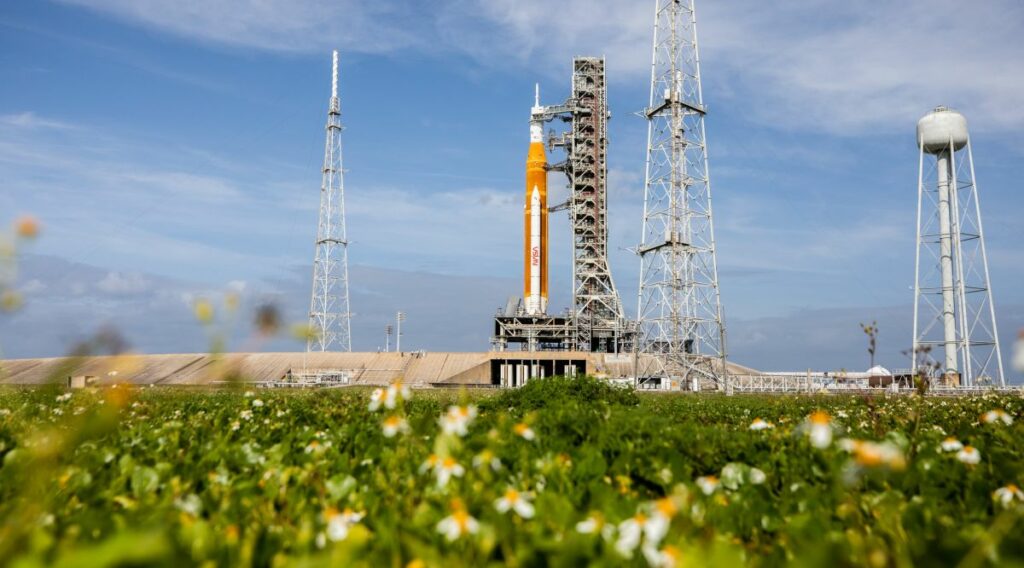The first three lunar launch opportunities are in late August and early September, pending a modification to the megarocket.
NASA hopes to have its lunar megarocket off the ground as soon as late August.
NASA is working on three “placeholder” launch dates for Artemis 1, an unguided test flight around the moon that serves as a keystone for testing future human missions: August 29, September 2 and 5. These dates are pending repairs. And NASA has made changes to the Space Launch System rocket and related systems in light of the results of a “wet dress rehearsal” on June 20, which NASA declared a success, officials said in a teleconference with media on Wednesday (July 20).
“It’s not an agency commitment,” Jim Free, NASA’s associate administrator for exploration systems, said of the interim launch dates. NASA will announce a firmer commitment about a week before launch, he said, when the agency completes a standard flight readiness review of the Artemis 1 stack, which includes the SLS and the Orion capsule atop the rocket.
The interim dates of late August and early September, however, “the team is working on and have a plan for,” Free added. “But [we] have a lot of work left that we have to do and probably learn with close-outs.”
Close-outs are interim approvals on key systems needed for launch, a flight to the moon, and a splashdown on Earth. NASA has a checklist of items to perform on the SLS stack before it leaves the Vehicle Assembly Building at NASA’s Kennedy Space Center in Florida, where work is underway to fix problems encountered during wet dress rehearsals.
Artemis 1’s most recent wet dress rehearsal was deemed good enough by NASA to proceed with launch preparations. During the three-day test, engineers fully fueled the SLS for the first time. But the team discovered a hydrogen leak from the core stage’s engine cooling system “umbilical cord” line.
During the test, the leak was resolved by closing the bleed valve in the hydrogen flow path. This workaround allowed the team to complete the wet dress, but it would not work during an actual launch because closing the bleed valve leaves the engine thermal system without proper regulation. (Operators ran a software “mask” during the test to advance the countdown, allowing the ground launch sequencer to flag temperature variations as designed.)
It then rolled-back to VAB on 2 July for maintenance, including repairs to the Aft SLS umbilical quick-disconnect component responsible for the hydrogen leak. Technicians are also performing vehicle inspections, repairing hydrogen leaks, replacing seals on the core stage, installing flight batteries, stowing payloads and performing power tests on Orion and loading software onto the SLS core stage and upper stages.
NASA officials said during the call Wednesday that they are making good progress on the repairs, but proceed carefully to ensure that Artemis 1 is ready before it leaves the building. Crews have already replaced the navigation and control assembly unit and are testing batteries and checking on the interim cryogenic propulsion stage that will give the Orion capsule a kick toward the moon during its mission.
Artemis 1 must pass a rigorous set of operations maintenance requirements “to say the vehicle is ready,” said Cliff Lanham, senior vehicle operations manager for NASA’s Exploration Ground Systems Program.
Only once the SLS stack completes those tests at VAB will it be authorized to go to the pad, which could happen on August 18 if all goes well.
While the full suite of tests is lengthy, some of the key tests the agency is looking at include the SLS’ flight termination system, the rocket’s engine section, the rocket’s core stage forward skirt that houses the flight computer and avionics system, and the Orion spacecraft.
NASA officials said each of the three launch attempts varied in mission duration and launch time. Launch opportunities on August 29 will open at 8:33 a.m. EDT (1333 GMT) and last two hours; Assuming a successful launch of Artemis 1, the Orion capsule will return to Earth 42 days later on October 10.
September 2 offers a two-hour launch window that opens at 12:48 p.m. EDT (1748 GMT); In this scenario, Artemis 1 will return 39 days later on October 11. Last Chance, September 5, covers a 1.5-hour launch window starting at 5:12 p.m. EDT (2212 GMT) and will see Artemis 1 return 42 days later, on October 17.
As a backup, the agency has identified several interim launch opportunities through mid-2023, in case weather or technical issues delay Artemis 1.


